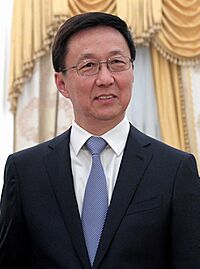Vice President of the People's Republic of China facts for kids
Quick facts for kids Vice President of the People's Republic of China |
|
|---|---|

|
|
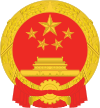
National Emblem of the People's Republic of China
|
|
| Style | Mr Vice President (副主席) (informal) His Excellency (阁下) (diplomatic) |
| Residence | Zhongnanhai |
| Seat | Zhongnanhai West Building, Beijing |
| Nominator | Presidium of the National People's Congress |
| Appointer | National People's Congress |
| Term length | Five years, renewable |
| Constituting instrument | Constitution of the People's Republic of China |
| Inaugural holder | Zhu De |
| Formation | 27 September 1954 |
| Abolished | Between 1975 and 1982 |
| Vice President of the People's Republic of China | |||||||
|---|---|---|---|---|---|---|---|
| Simplified Chinese | 中华人民共和国副主席 | ||||||
|
|||||||
| Alternative Chinese name | |||||||
| Simplified Chinese | 国家副主席 | ||||||
|
|||||||
The vice president of the People's Republic of China, commonly called the vice president of China, is the deputy to the president of the People's Republic of China, the state representative of China.
The office was first established in the Constitution in 1954, with the official English-language translation of "state vice chairman". The post of vice chairman was abolished under the Constitution of 1975 together with the chairman, then reinstated in the Constitution of 1982. Since 1982, the title's official English-language translation has been "vice president", although the Chinese title remains unchanged. The new constitution stipulated that the vice president could not serve more than two consecutive terms; the term limits were removed in 2018.
Under the current constitution, the president serves at the pleasure of the National People's Congress (NPC), the legislature. According to the constitution, the principal duty of the vice president is assisting the president in their duties. The vice president also assumes the presidency in case the office becomes vacant until a new president is elected by the NPC. The incumbent vice president of China is Han Zheng, who took office in 10 March 2023.
Contents
History
The office of state vice chairman was first established under the 1954 Constitution, together with the chairman. It was, along with the state chairman, abolished in the new Constitution adopted by the 4th National People's Congress (NPC) in 1975.
The office, now called the vice president, was restored in the 1982 constitution together with the presidency. The new constitution mandated term limits for the office, stipulating the president and vice president could not serve more than two consecutive terms.
Vice President Li Yuanchao was a member of the CCP Politburo until 2017, but not the Standing Committee.
On March 11, 2018, the first session of the 13th National People's Congress, by a vote of 2,958 in favor, two opposed and three abstaining, passed a constitutional amendment that removed the previous term limits for the president and the vice president. Wang Qishan was elected as the vice president during the session; he was a retired member of the Politburo Standing Committee at the time of his ascension. Han Zheng, who succeeded Wang Qishan as the vice president in 2023, was also a retired member of the politburo standing committee at the time of his ascension.
Selection
Eligibility
Article 79 of the Constitution sets three qualifications for being elected for the vice presidency. To serve as president, one must:
- be a Chinese citizen;
- have the right to vote and stand for election;
- be at least 45 years old.
Election
According to the Organic Law of the National People's Congress (NPC), constitutionally China's highest organ of state power, the vice president is nominated by the NPC Presidium, the Congress's executive organ. However, the nomination is effectively made by the Chinese Communist Party, with the decisions being made among Party leaders. Although the Presidium could theoretically nominate multiple candidates for the presidency, leading the election to be competitive, it has always nominated a single candidate for the office.
After the nomination, the vice president is elected by the NPC, which also has the power to remove the vice president and other state officers from office. Elections and removals are decided by majority vote. The length of the vice president's term of office is the same as the NPC, which is 5 years. Since 2018, the vice president is required to recite the constitutional oath of office before assuming office.
Powers
The vice president's duties constitutionally include assisting the president, and exercise part of their functions and powers on behalf of the president. The vice president also becomes the president in case the office becomes vacant until a new president is elected by the NPC. In case the vice presidency becomes vacant, the NPC elects a new vice president.
In practice, the position of the vice president is mostly ceremonial; Vice presidents Hu Jintao, Zeng Qinghong and Xi Jinping have been members of the Politburo Standing Committee of the Chinese Communist Party (CCP) and the Central Secretariat, the country's main decision making bodies; these three served concurrently as the first secretary of the Secretariat, in charge of party affairs.
The vice president may play a major role in foreign affairs. For instance, the vice president generally sits on the Central Foreign Affairs Commission, a policy coordination body of the CCP. The vice president has also typically sits on the Central Leading Group on Hong Kong and Macau Affairs. Therefore, while the vice president may not actually have substantive powers as defined in the Constitution, the office nonetheless carries significance and prestige. The holders of the office have all been individuals with a degree of political clout.
List of vice presidents
- Generations of leadership
First Administration Second Administration Third Administration Hu–Wen Administration Xi–Li Administration/Xi Jinping Administration
Central People's Government (1949–1954)
- Vice Chairmen of the Central People's Government
- (co-serving, 1 October 1949 – 27 September 1954)
- Zhu De
- Liu Shaoqi
- Song Qingling
- Li Jishen
- Zhang Lan
- Gao Gang (until his death on 17 August 1954)
The 1st Constitution (1954–1975)
| Portrait | Name (Birth–Death) Constituency |
Term of office | NPC | Chairman | |||
|---|---|---|---|---|---|---|---|
| 1 |  |
Zhu De 朱德 (1886–1976) Sichuan at-large |
27 September 1954 | 27 April 1959 | I | Mao Zedong | |
| The first Vice Chairman of the People's Republic of China. | |||||||
| 2 |  |
Song Qingling 宋庆龄 (1893–1981) Shanghai at-large |
Dong Biwu 董必武 (1886–1975) Hubei at-large |
27 April 1959 | 17 January 1975 | II · III | Liu Shaoqi |
| Served jointly as Vice Chairmen. | |||||||
| Vacancy by ascension and post abolished | |||||||
The 4th Constitution (1982–present)
| Portrait | Name (Birth–Death) Constituency |
Term of office | NPC | President | ||
|---|---|---|---|---|---|---|
| 3 | 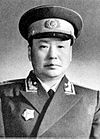 |
Ulanhu 乌兰夫 (1907–1988) Inner Mongolia at-large |
18 June 1983 | 8 April 1988 | VI | Li Xiannian |
| An ethnic Mongol and former Chairman of Inner Mongolia, Ulanhu served as the first vice president under the 4th Constitution of the People's Republic of China. | ||||||
| 4 | 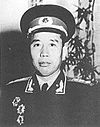 |
Wang Zhen 王震 (1909–1993) Xinjiang at-large |
8 April 1988 | 12 March 1993 | VII | Yang Shangkun |
| Wang Zhen, a Communist military leader, was perhaps best known for leading the People's Liberation Army into Xinjiang at the foundation of the People's Republic. In 1988 Wang assumed the title of Vice-President in an honorary capacity, after his failed effort to put the conservative Deng Liqun in the position of General Secretary. Wang was the second vice president under the 4th Constitution of the People's Republic of China. He died in office. | ||||||
| 5 | 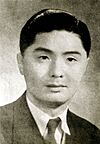 |
Rong Yiren 荣毅仁 (1916–2005) Shanghai at-large |
12 March 1993 | 15 March 1998 | VIII | Jiang Zemin |
| A member of the China Democratic National Construction Association, a recognized non-Communist political party in China, Rong served as the third vice president under the 4th Constitution of the People's Republic of China. | ||||||
| 6 | 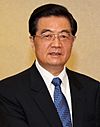 |
Hu Jintao 胡锦涛 (born 1942) Guizhou at-large |
15 March 1998 | 15 March 2003 | IX | Jiang Zemin |
| Hu, the former party chief of Guizhou province and the Tibet Autonomous Region, served as the fourth vice president under the 4th Constitution of the People's Republic of China. In his capacity as Vice-President, Hu was probably best known for handling the aftermath of the United States bombing of the Chinese embassy in Belgrade. Hu was the first member of the Politburo Standing Committee to assume the post since the adoption of the 1982 constitution. In 2003, Hu became the first vice president to become president. | ||||||
| 7 | 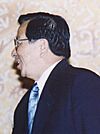 |
Zeng Qinghong 曾庆红 (born 1939) Jiangxi at-large |
15 March 2003 | 15 March 2008 | X | Hu Jintao |
| Zeng Qinghong, who had come to prominence as a political aide to Jiang Zemin, served as the fifth vice president under the 4th Constitution of the People's Republic of China. Also a member of the Politburo Standing Committee, Zeng received an unusually high number of votes against him during his election for the vice-presidency. | ||||||
| 8 | 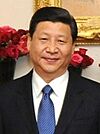 |
Xi Jinping 习近平 (born 1953) Shanghai at-large |
15 March 2008 | 14 March 2013 | XI | Hu Jintao |
| Xi, the former party chief of Zhejiang, then Shanghai, became the sixth vice president under the 4th Constitution of the People's Republic of China and the second vice president to become president. Also a member of the Politburo Standing Committee. | ||||||
| 9 | 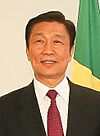 |
Li Yuanchao 李源潮 (born 1950) Jiangsu at-large |
14 March 2013 | 17 March 2018 | XII | Xi Jinping |
| Li, the former party chief of Jiangsu, became the seventh vice president under the 4th Constitution of the People's Republic of China. A member of the Politburo. In his capacity as Vice-President, Li represented China at numerous international events of symbolic significance, such as the State Memorial Service of Nelson Mandela, and the state funeral of Lee Kuan Yew. | ||||||
| 10 |  |
Wang Qishan 王岐山 (born 1948) Hunan at-large |
17 March 2018 | 10 March 2023 | XIII | Xi Jinping |
| Wang, a retired member of the Politburo Standing Committee and the former Secretary of the Central Commission for Discipline Inspection – China's top anti-corruption enforcer, was selected for the vice president post ostensibly for his experience in foreign affairs. Wang's assuming the post again made the vice-presidency a highly relevant office. | ||||||
| 11 |  |
Han Zheng 韩正 (born 1954) Shanghai at-large |
10 March 2023 | Incumbent | XIV | Xi Jinping |
| Han, a retired member of the Politburo Standing Committee and the former first-ranked Vice-Premier of the State Council, was selected for the vice president post. | ||||||
See also
 In Spanish: Vicepresidente de la República Popular China para niños
In Spanish: Vicepresidente de la República Popular China para niños
- Order of precedence in China
- List of current vice presidents and designated acting presidents


